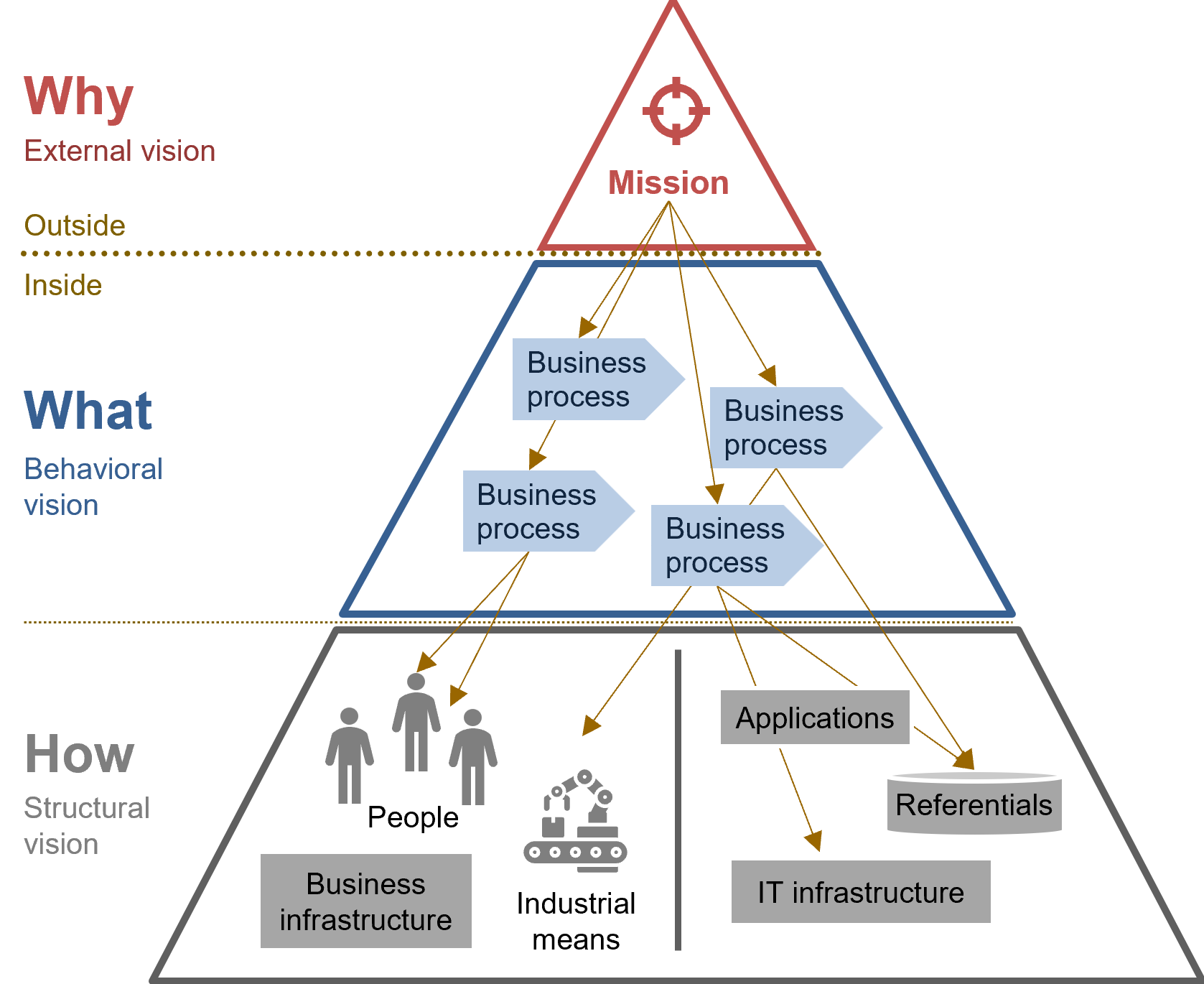AI assisted MBSE
GENERATIVE AI FOR SYSTEMS ENGINEERING
Generative AI, a catalyst for systems engineering practices
The effectiveness of AI is not measured solely by its technical capabilities, but above all by its relevance to the context and practices of each company. Its adoption must be aligned with the organization’s specific challenges to maximize its impact. When intelligently combined with a systems engineering approach, it can significantly increase the operational efficiency of project teams.
| Leveraging Generative AI in Systems Engineering
Cesames has developed a distinct and recognized expertise in the application of generative AI to systems engineering, based on the synergy of four key areas of expertise:
1 | In-depth knowledge of business best practices, acquired through significant experience with systems engineering practices and needs across numerous industrial sectors.
2 | A solid understanding of systems engineering architecture and methods, enabled by the CESAM framework and its rigorous semantics.
3 | Proven expertise in best practices for applying generative AI tools to maximize added value and improve systems engineering deliverables.
4 | A deep understanding of process transformation, as well as that of engineering-related organizations and toolchains.
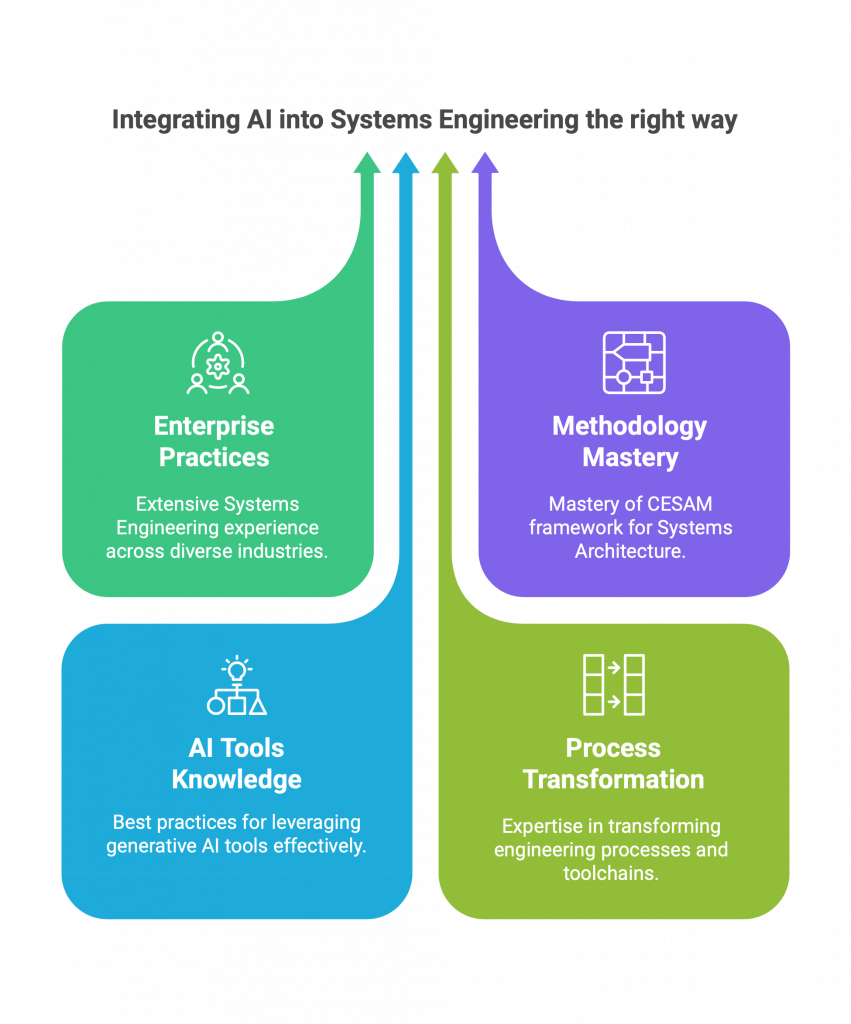
Ignoring any of these elements can lead to unsatisfactory results:
➤ Without solid systems engineering expertise, AI-based solutions risk being disconnected from practical realities.
➤ Without a structured MBSE approach (such as the CESAM method), AI-generated content may lack consistency and accuracy.
➤ If generative AI best practices are not applied, results may be insufficient, sometimes erroneous, requiring manual adjustments.
➤ Finally, without expertise in transforming engineering processes, AI integration remains fragmented and ineffective.
| A structured and pragmatic approach
Une adoption de l’IA générative maîtrisée
Notre objectif est de fournir une valeur tangible et pérenne en intégrant l’IA générative dans le domaine de l’ingénierie des systèmes, avec une approche structurée, personnalisée et alignée sur votre stratégie d’entreprise :
➤ Accompagner son intégration dans l’organisation en maîtrisant ses impacts pour en tirer une véritable valeur ajoutée.
➤ Optimiser son utilisation pour l’ingénierie système, en sachant à la fois l’exploiter et la challenger efficacement.
Intégration progressive de l’IA générative dans les pratiques MBSE
L’IA générative est un domaine en pleine évolution qui requiert une approche réfléchie pour son intégration dans les pratiques de MBSE. Il est préférable de définir un périmètre d’activité clair et d’adopter une intégration progressive, plutôt que de lancer des initiatives désordonnées, ce qui pourrait nuire à l’efficacité et au contrôle des processus.
Pour assurer une mise en œuvre efficace de l’IA générative dans l’ingénierie système, Cesames adresse un certain nombre de cas d’usage propre aux ingénieurs et architectes systèmes, mais également à la gouvernance des données.
| CESAM Framework Assistant: a GPT, assistant to the system architect
True to its pragmatic approach, Cesames supports the entire engineering value chain, helping to define solutions based on generative AI adapted to the company’s specific challenges and practices.
This approach is notably reflected in the creation of a first AI assistant (a GPT), specially designed within ChatGPT to master the CESAM systems architecture framework.
This assistant’s knowledge base is a body of documentation based on best practices in systems architecture and the CESAM Pocket Guide.
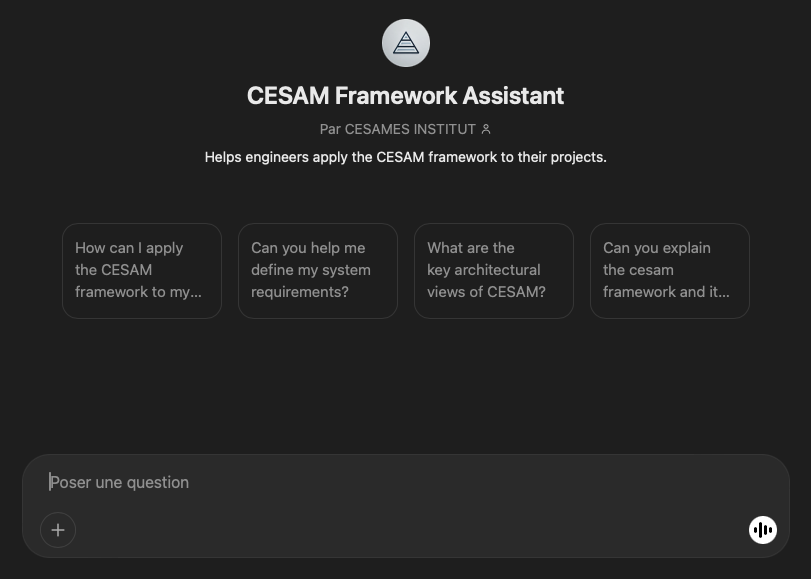
If you would like an unbridled version, please contact us.
| Our support offers
Cesames offers three progressive offerings to help implement generative AI in your systems engineering:
1 | Generative AI Awareness for Systems Engineering: Understand the fundamentals and challenges.
2 | Coaching in the Use of Generative AI: Assist in the production of comprehensive and coherent architecture studies.
3 | Strategic Support for AI Implementation: Deploy an AI tailored to your organization and maximize its impact.
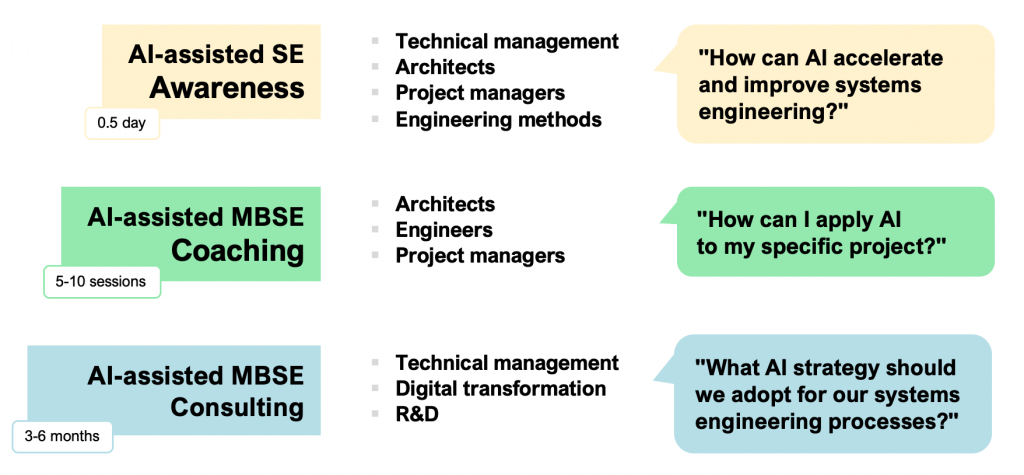
| Our support offers
Cesames offers three progressive offerings to help implement generative AI in your systems engineering:
1 | Generative AI Awareness for Systems Engineering: Understand the fundamentals and challenges.
2 | Coaching in the Use of Generative AI: Assist in the production of comprehensive and coherent architecture studies.
3 | Strategic Support for AI Implementation: Deploy an AI tailored to your organization and maximize its impact.
Product / Service
What problem are we addressing?
Who is concerned?
What needs do we cover?
“How can AI accelerate and improve systems engineering?”
– Technical management
– Architects
– Project managers
– Method teams
– Grasp the fundamentals of generative AI
– Apply best practices for effective AI usage for Systems Engineering
– Explore AI opportunities (SysML v2, private bases)
“How can I apply AI to my specific project?”
– Architects
– Engineers
– Project managers
Apply AI to some SE activities on a concrete case:
– Read text and diagrams
– Build a view
– Build an architecture
– Validate a view
– Validate an architecture
– Comply with a framework
“What AI strategy should we adopt for our systems engineering processes?”
– Technical management
– Digital transformation
– R&D
– Make informed decisions on where to implement and not implement AI in engineering
– Make informed decisions on AI implementation strategy according to your practices and challenges
1 | AI-assisted SE Awareness
How can AI accelerate and improve systems engineering?
➤ The CESAMES approach:
Demystify generative AI in systems engineering. Clarify what it is and what it isn’t, and explore how to integrate it effectively, while remaining anchored in the business expertise of systems engineers.
➤ What format?
A half-day training session (in-person or remotely)
➤ Who is involved?
Engineers
System Architects
Project Managers
Managers
➤ What needs do we cover?
Understand the basics of generative AI
Know which systems engineering activities generative AI can and cannot support
Become a successful user of generative AI, powered by the CESAM framework
Training program
I. Introduction (15 min)
II. Generative AI Awareness (30 min)
— Precautions with Generative AI
— General Operation of LLMs
— Available Tools and Recommendations
III. Best Practices for Use (45 min)
— Choosing and Configuring Your GPT
— Writing Effective Prompts
— Using Classic Functions
IV. IS Scope Considered (30 min)
— AI for Which IS Activities
— Semantics of the CESAM Framework
V. Best Practices in AI for IS (45 min)
— Generic Use Cases
— AI Combinations and Tools
— Systems Engineering Use Cases
VI. Group Exercise: Environment Diagram and Requirements (60 min)
VII. Perspectives and Conclusion (30 min)
— AI Possibilities with SysML v2
— Specialized Tools and Private Databases
2 | AI-assisted SE Coaching
Generative AI doesn’t replace the architect: it assists them (if handled well!), accelerates their thinking, and allows them to better structure their approach. Our mission is to help our clients fully exploit this potential while maintaining the rigor and control necessary for robust and adapted architectures.
➤ Coaching in architecture assisted by generative AI
Cesames uses a structured and pragmatic methodology for generating complete architectures and their associated needs and requirements.
Thanks to its in-depth understanding of the concepts and their connections within the CESAM framework, Cesames is uniquely positioned to evolve this conventional approach into a methodology enhanced by generative AI.
Collective intelligence and iteration remain at the heart of both approaches.
➤ A proven coaching posture
With more than 1,500 projects coached, the stance of listening and deep respect for practices is in Cesames’ DNA, while providing a challenging and structuring perspective.
➤ In practice
Our coaching is based on a methodical approach, which includes:
1. Selection of activities to be covered
2. Organization of sessions*: duration and frequency
3. Number of sessions, à la carte, remotely
4. Coaching sessions: Individualized coaching, review of work completed, answering questions, co-developing solutions
5. Can be combined with targeted awareness training for effective use of AI tools.
(*)one session = 1.5/2 hours online
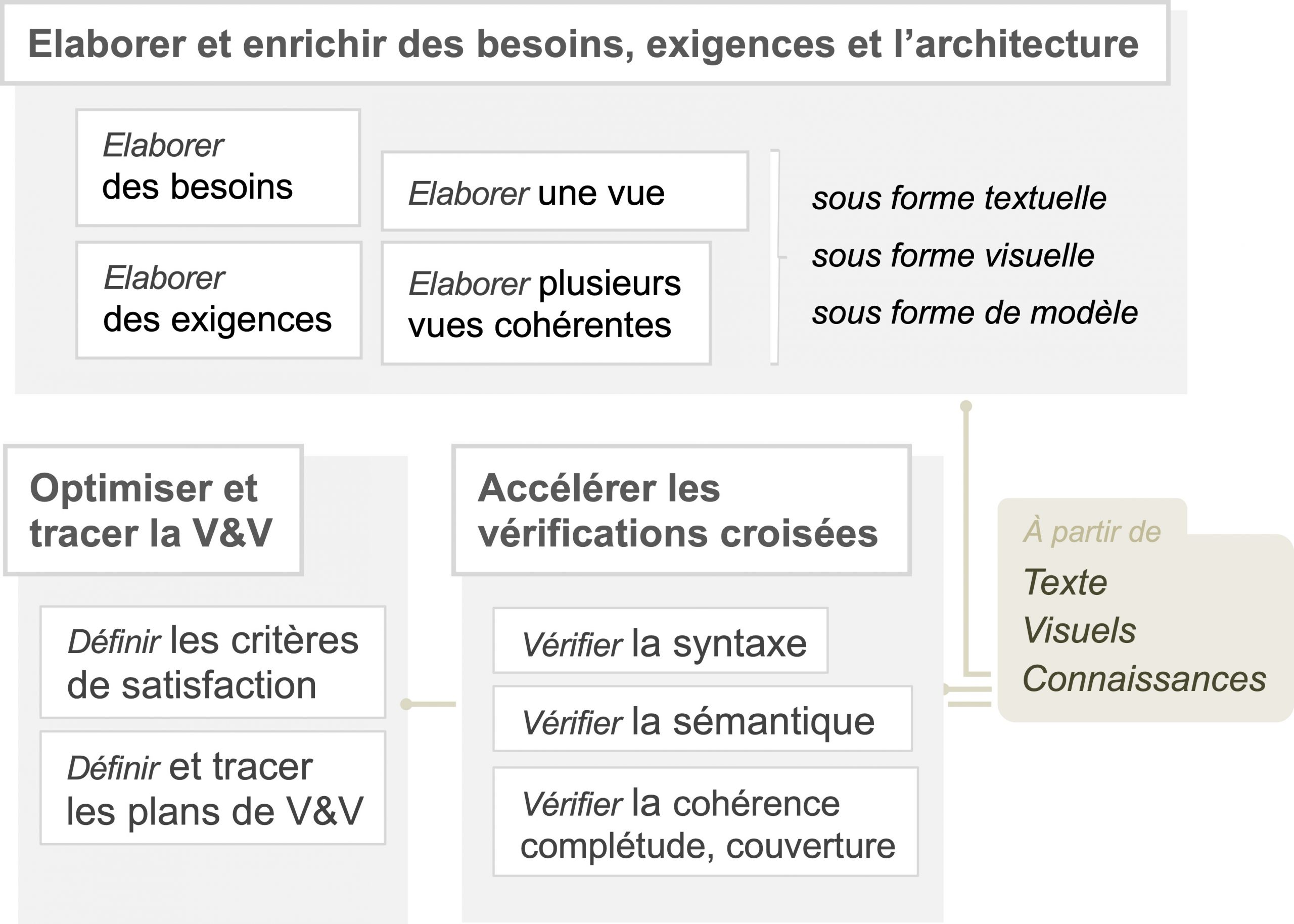
3 | AI-assisted SE Consulting
Delivering strong local added value only makes sense if it’s part of a global and sustainable dynamic. Generative AI is a powerful lever, but its success depends above all on thoughtful integration aligned with the realities of the business.
➤ Key principles of the approach
— A comprehensive vision: understanding the global impact of AI and ensuring governance capable of adapting to technological developments, whether they represent proven breakthroughs or unfulfilled promises.
— Local applications with high added value: identifying and implementing concrete use cases that generate immediate benefits while being part of a coherent long-term strategy.
— A structured and collaborative approach: Cesames’ DNA is resolutely collaborative; the adoption of AI can only succeed if it integrates harmoniously with the organization’s existing practices and human dynamics.
➤ Key steps of the approach
1. Assessment: Analysis of current practices and specific needs.
2. Definition of a vision and realistic objectives: Setting a target adapted to the company’s challenges.
3. Identification of technical enablers: Selecting the necessary tools and infrastructure.
4. Process impact assessment: Adapting workflows to maximize added value.
5. Organizational impact analysis: Supporting change and ensuring team buy-in.
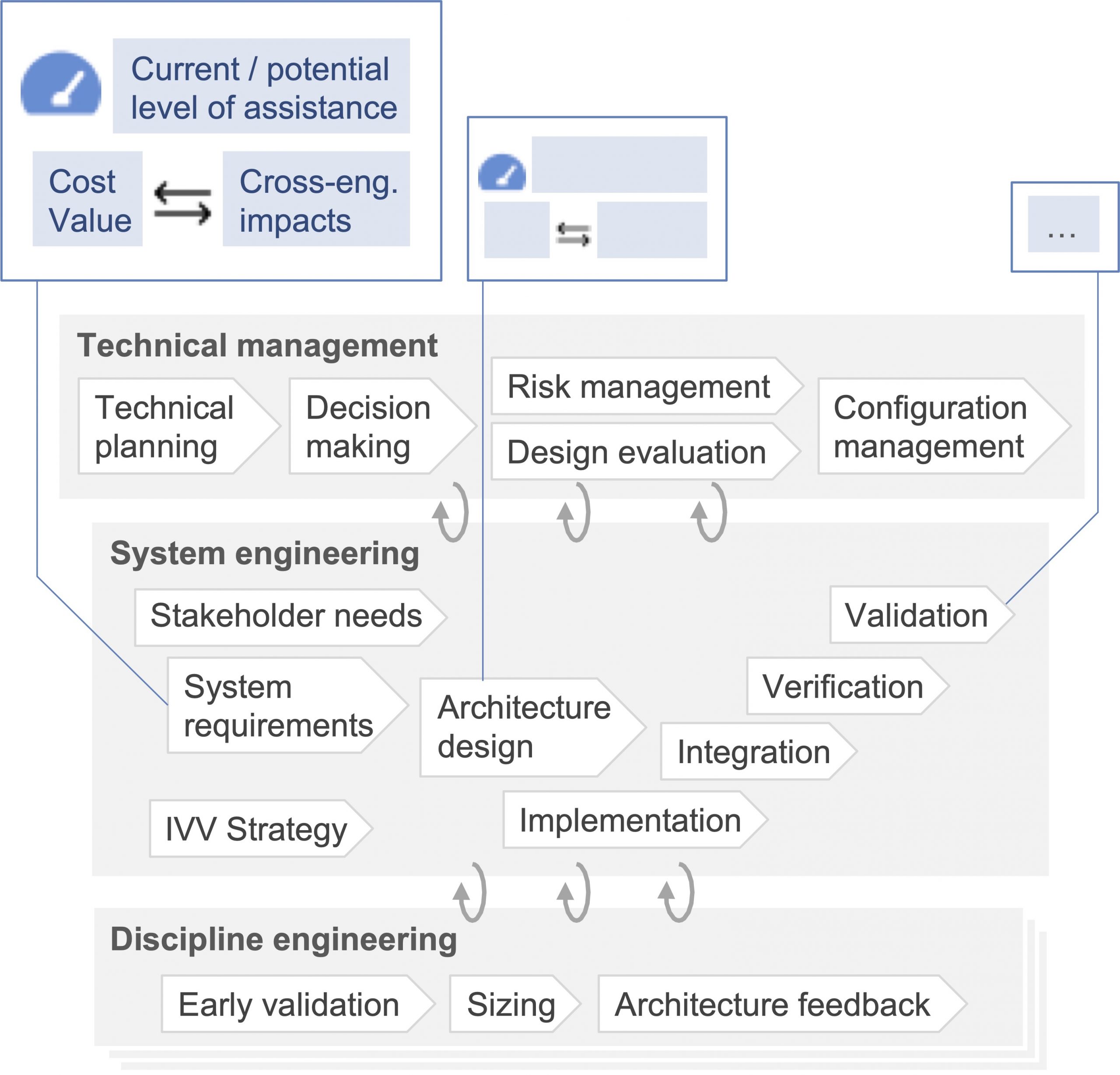
||||| Ressources
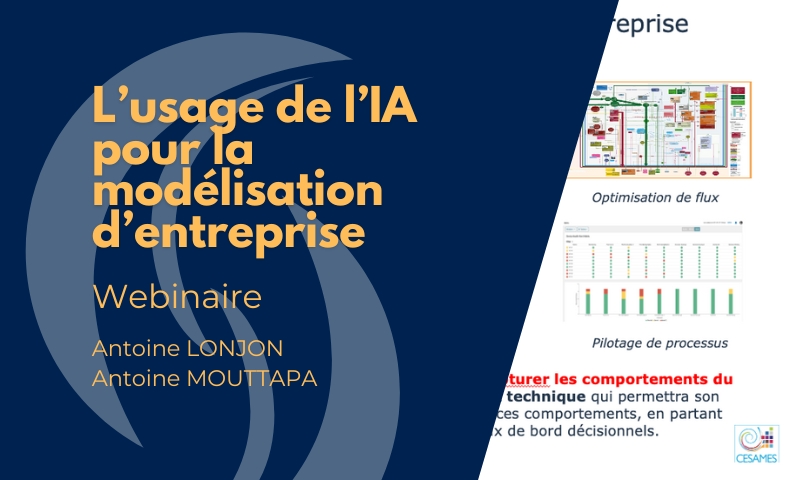
Webinaire [FR]
L’usage de l’IA pour la modélisation d’entreprise
Les avancées de l’intelligence artificielle dans les méthodes d’apprentissage ne sont plus à démontrer. Les dernières découvertes en biologie moléculaire de l’outil Alpahfold développé par DeepMind de Google en font foi. En sera-t-il de même pour la modélisation des entreprises : quel est le potentiel de l’intelligence artificielle « hybride » au service de l’architecture ?
Antoine Lonjon, Chief Innovation Officer chez MEGA International, apporte ici des débuts de réponses à l’aide de quelques cas d’emploi pratiques.
Antoine Mouttapa, Architecte expert chez CESAMES, partage des exemples de modèles d’architecture d’entreprise s’appuyant sur l’apprentissage en IA
| L’approche de CESAMES : intégrée et collaborative
Notre différence :
➤ Double expertise en architecture système et d’entreprise, acquise dans de nombreux secteurs.
➤ Utilisation d’un cadre d’architecture d’entreprise clair (CESAM), pragmatique et éprouvé pour maîtriser la complexité.
➤ Approche intégrant différentes perspectives : vision externe, vision métier, et vision du système d’information.
➤ Cadre d’architecture aligné avec celui de l’architecture système.
➤ Compatibilité avec le cadre TOGAF, en tant que volet opérationnel immédiatement applicable.
